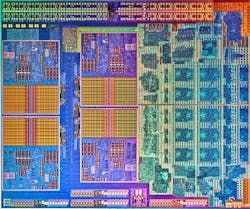They have been busy as beavers over at AMD resulting in a host of announcements. This is after the recent Project SkyBridge announcement about their 64-bit ARM offerings (see “AMD's Project SkyBridge Unifies x86 And 64-bit ARM”). This latest crop of announcements concentrates on the x86 side of things where AMD's Accelerated Processing Units (APU) are multiplying like rabbits. It was only a couple years ago that the APU appeared (see “APU Blends Quad Core x86 With 384 Core GPU”).
Heading off the announcements is the availability of the AMD A-Series Mobile APUs (Fig. 1). This complements the AMD A-Series APUs formally known as “Kavari” for the desktop (see “Heterogeneous System Architecture Changes CPU/GPU Software”). Both support AMD's Heterogeneous System Architecture (HSA) whereas the original APUs just combined CPU and GPU cores. HSA provides an integrated virtual memory space that is shared by CPUs and GPUs. It also provides hardware scheduling support. Both support AMD's Mantle as well as AMD's other multimedia technologies (see “What's The Difference Between AMD's Mantle and Media SDK”) including support for 4K UltraHD displays and AMD TrueAudio technology.
At the heart are a dozen cores. This includes four CPU and four GPU cores. The CPU cores us AMD's Steamroller architecture. The GPU cores use AMD's Graphics Core Next (GCN) architecture that is found in their latest dedicated Radeon GPUs.
AMD has also released the high end FX series. This is designed for mobile gaming systems and has the Radeon R7 graphics support in the GPU cores. This supports OpenCL as well as Microsoft's DirectX 11.2.
Part of the announcement mix is AMD's PRO series. These are the first HSA-compatible chips that come with long term support. They have a 24-month life cycle. Hewlett-Packard is using the AMD PRO in its EliteDesk series. The AMD PRO series targets commercial offerings versus embedded solutions that often need a longer lifecycle.
Embedded APUs
Another announcement in the mix is the extension of AMD's Embedded G-Series. The new G-Series APU SoCs, codenamed “Steppe Eagle,” are pin compatible with the previous generation while incorporating new features like the platform security processor (PSP) that uses an ARM Cortex-A5 with ARM TrustZone support to provide a more secure system. At the low end is a 5 W TDP SoC.
The G-Series CPU solutions, codenamed “Crowned Eagle,” provide higher performance that can handle DDR3-1600 including ECC support. It has integrated PCI Express Gen 2 and USB 3.0 support as well as SATA ports.
The G-Series can run a range of operating systems including Windows 8 and Linux. The Embedded G-Series is supported via the Yocto Project by AMD and Mentor Graphics (see “Interview: AMD and Mentor Graphics Partner To Deliver Linux”). This particular support targets Mentor's Embedded Linux (Fig. 2) as well as Mentor's toolset and support system.
AMD continues to deliver on its APU and HSA promises. Software that can take advantage of HSA can now be utilized in a wider range of platforms.
About the Author
William G. Wong
Senior Content Director - Electronic Design and Microwaves & RF
I am Editor of Electronic Design focusing on embedded, software, and systems. As Senior Content Director, I also manage Microwaves & RF and I work with a great team of editors to provide engineers, programmers, developers and technical managers with interesting and useful articles and videos on a regular basis. Check out our free newsletters to see the latest content.
You can send press releases for new products for possible coverage on the website. I am also interested in receiving contributed articles for publishing on our website. Use our template and send to me along with a signed release form.
Check out my blog, AltEmbedded on Electronic Design, as well as his latest articles on this site that are listed below.
You can visit my social media via these links:
- AltEmbedded on Electronic Design
- Bill Wong on Facebook
- @AltEmbedded on Twitter
- Bill Wong on LinkedIn
I earned a Bachelor of Electrical Engineering at the Georgia Institute of Technology and a Masters in Computer Science from Rutgers University. I still do a bit of programming using everything from C and C++ to Rust and Ada/SPARK. I do a bit of PHP programming for Drupal websites. I have posted a few Drupal modules.
I still get a hand on software and electronic hardware. Some of this can be found on our Kit Close-Up video series. You can also see me on many of our TechXchange Talk videos. I am interested in a range of projects from robotics to artificial intelligence.



